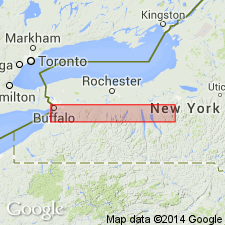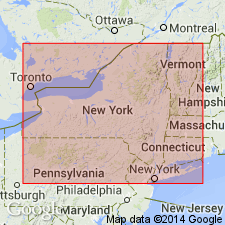
- Usage in publication:
-
- Bay View coral bed
- Modifications:
-
- Named
- Dominant lithology:
-
- Mudstone
- Limestone
- AAPG geologic province:
-
- Appalachian basin
Summary:
The coral-rich bed in the lower-middle part of the Windom Shale Member of the Moscow Formation of the Hamilton Group is here [informally] named the Bay View coral bed. This important marker bed extends for 150 km from Lake Erie east to Onondaga Co., NY. The western facies, 15 to 30 cm thick, consists of coral and other fossils in soft, blocky, gray mudstone. The eastern facies, 1 to 2 m thick, is gray, fissile to blocky, calcareous mudstone with shell beds and nonseptarian concretions. Overlies the AMBOCOELIA UMBONATA of Brett (1974); underlies the "coral-trilobite bed" of Brett (1974), here termed the Smoke Creek bed of the Windom. Age is Middle Devonian.
Source: GNU records (USGS DDS-6; Reston GNULEX).

- Usage in publication:
-
- Bay View coral bed
- Modifications:
-
- Overview
- AAPG geologic province:
-
- Appalachian basin
Summary:
Windom Shale Member of Moscow Formation reaches a maximum thickness of 60 m in the eastern Finger Lakes area of NY. Here it consists of medium to dark gray fossiliferous mudstones and shales with thin concretionary limestone beds and can be divided into approximately 15 informal major traceable units and a number of thin, localized shell-rich beds. Unit 4 has been designated the Bay View coral bed (Baird and Brett, 1983). (See Windom for complete list of units.) Bed is 1.0 to 1.2 m of highly fossiliferous, medium gray mudstone containing thin shell-rich layers. Bed is extremely rich in small rugose Corals, and brachiopods. In western Erie Co., interval thins to 0.5 m and becomes rich in large rugose corals. Cleland (1903) referred to this interval as the STROPHEODONTA-Coralline zone at Cayuga Lake. Interval has been traced eastward at least to Skaneateles Lake. Overlies DEVONOCHONETES CORONATUS beds and underlies Smoke Creek bed. Age is Givetian.
Source: GNU records (USGS DDS-6; Reston GNULEX).
For more information, please contact Nancy Stamm, Geologic Names Committee Secretary.
Asterisk (*) indicates published by U.S. Geological Survey authors.
"No current usage" (†) implies that a name has been abandoned or has fallen into disuse. Former usage and, if known, replacement name given in parentheses ( ).
Slash (/) indicates name conflicts with nomenclatural guidelines (CSN, 1933; ACSN, 1961, 1970; NACSN, 1983, 2005, 2021). May be explained within brackets ([ ]).

